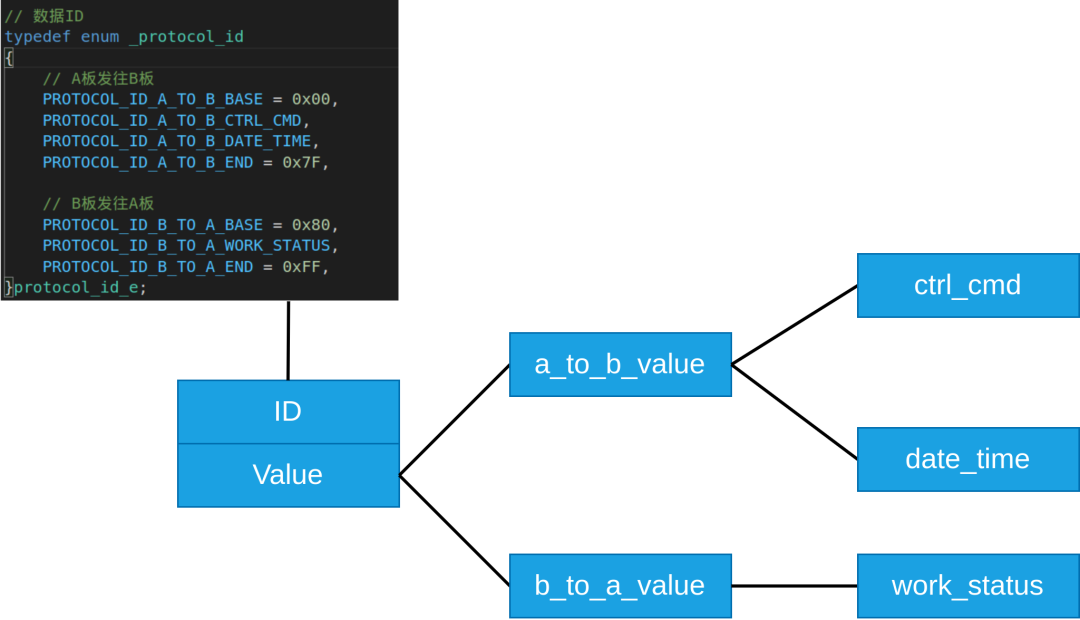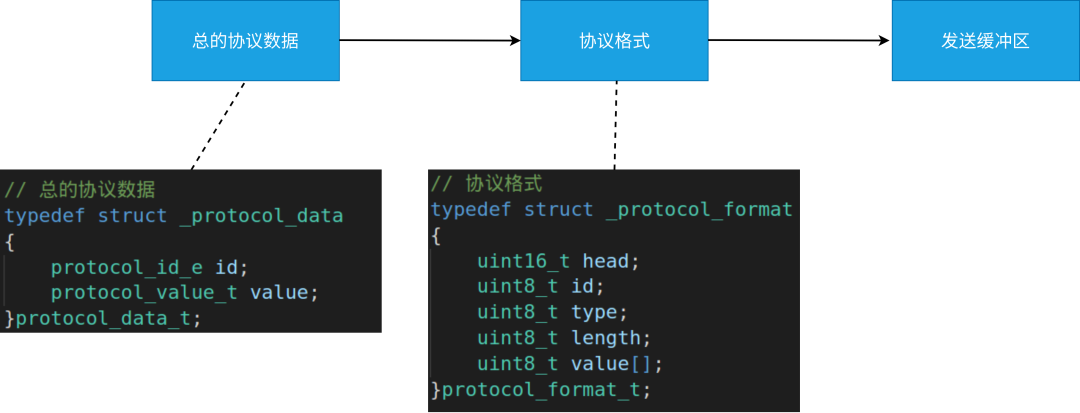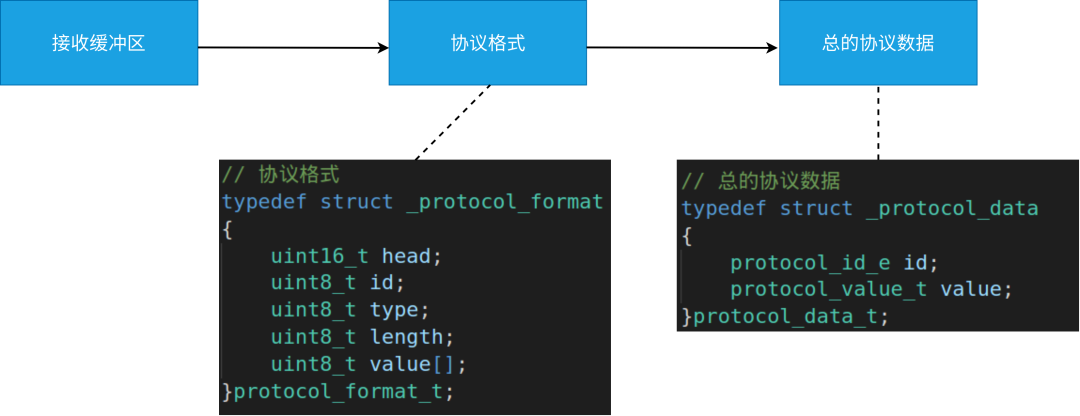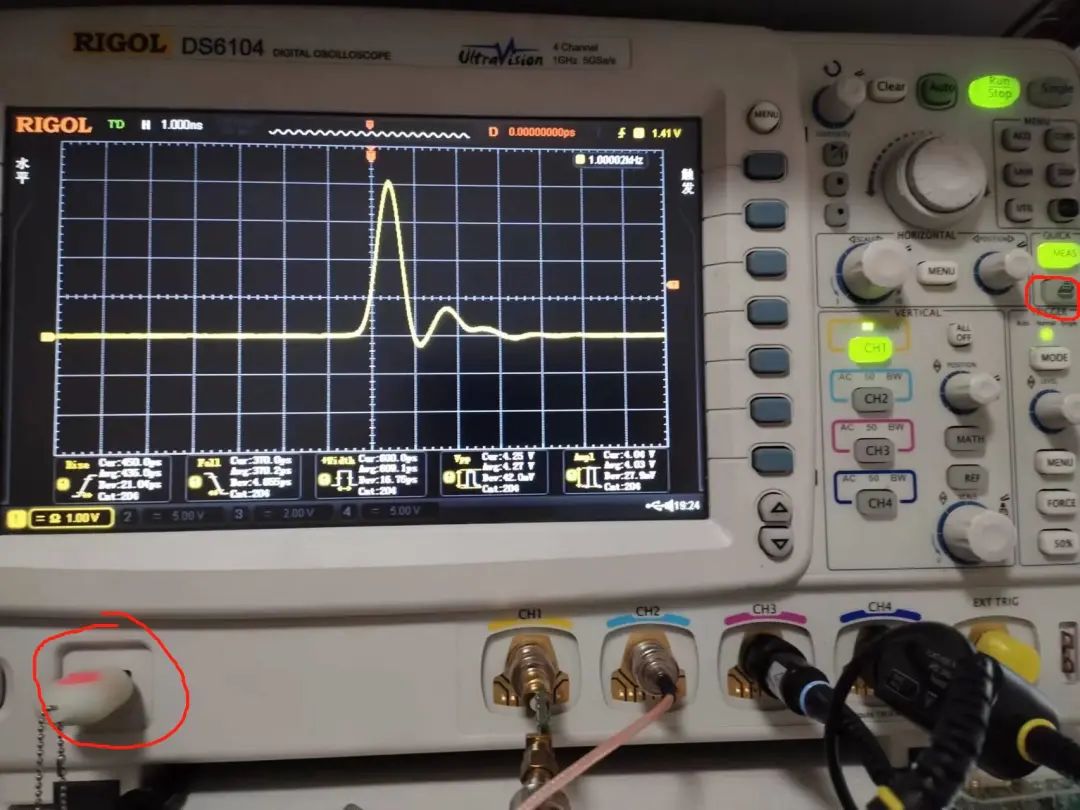嵌入式開發(fā)中,常常會自定義一些協(xié)議格式,比如用于板與板之間的通信、客戶端與服務(wù)端之間的通信等。
自定義的協(xié)議格式可能有很多種,本篇文章我們來介紹一種很常用、實用、且靈活性很高的協(xié)議格式——ITLV格式。
什么是ITLV格式?
大家可能看到網(wǎng)絡(luò)上的很多文章用的是TLV(Tag、Length、Value)格式數(shù)據(jù)。實際中,可以根據(jù)實際需要進行修改。我們這里稍微改一下,實際上也是大同小異的。
我們這里的ITLV各字段的含義:
I:ID或Index,用于區(qū)分是什么數(shù)據(jù)。
T:Type,代表數(shù)據(jù)類型,如int、float等。
L:Length,表示數(shù)據(jù)的長度(Value的長度)。
V:Value,表示實際的數(shù)據(jù)。
其中,I、T、L是固定長度的,在制定具體的數(shù)據(jù)協(xié)議之前,需要評估好當(dāng)前項目的數(shù)據(jù)會有多少、數(shù)據(jù)的最大長度是多少,考慮好后續(xù)數(shù)據(jù)擴展也可以保證協(xié)議通用。一般I設(shè)置為1~2字節(jié),T設(shè)置為1字節(jié),L設(shè)置為1~4字節(jié)。
下面我們制定一個格式:

實際中,如果在物聯(lián)網(wǎng)系統(tǒng)中數(shù)據(jù)傳輸,我們用戶自定義的協(xié)議字段可能就只包含如上四個字段就可以了。比如我們公司的云平臺上的用戶數(shù)據(jù)格式用的就是類似ITLV這樣的格式。用戶在制定協(xié)議時的協(xié)議字段包含如上字段就可以了。
沒有包頭做一些數(shù)據(jù)區(qū)分,也沒有校驗字段,只包含如上字段就能保證數(shù)據(jù)可靠傳輸嗎?
因為端云通信采用MQTT,基于TCP,TCP的特點就是可靠的,網(wǎng)絡(luò)協(xié)議中會帶有校驗。并且,實際在傳輸用戶數(shù)據(jù)時,還會再用戶數(shù)據(jù)之前增加一些字段區(qū)分這就是用戶數(shù)據(jù)。所以,其實基于它的設(shè)備SDK來進行開發(fā),操作的數(shù)據(jù)就是如上的數(shù)據(jù)。
但是,如果應(yīng)用于板與板之間的通信,只包含如上字段自然是有風(fēng)險的。我們至少還需要還要包頭、校驗字段。
實際中根據(jù)需要還可以增加其它字段,比如如果需要分包發(fā)送,還需要增加包號;如果多塊板之間進行通信,還需要增加發(fā)送數(shù)據(jù)目標(biāo)地址等。
這里我們增加包頭與校驗字段:

其中:
(1)Head固定為0x55、0xAA。
(2)Length為1字節(jié),即Value最大為256B。
ITLV格式數(shù)據(jù)處理
下面以例子來演示ITLV格式數(shù)據(jù)的處理。

下面我們以上面我們制定的協(xié)議編寫A板的組包、解析代碼。
1、設(shè)計相關(guān)數(shù)據(jù)結(jié)構(gòu)
首先,我們創(chuàng)建一個協(xié)議格式結(jié)構(gòu)體:
#pragmapack(1) //協(xié)議格式 typedefstruct_protocol_format { uint16_thead; uint8_tid; uint8_ttype; uint8_tlength; uint8_tvalue[]; }protocol_format_t;
type字段的取值:
//TLV數(shù)據(jù)類型type
typedefenum_tlv_type
{
TLV_TYPE_UINT8,
TLV_TYPE_INT8,
TLV_TYPE_UINT16,
TLV_TYPE_INT16,
TLV_TYPE_UINT32,
TLV_TYPE_INT32,
TLV_TYPE_STRING,
TLV_TYPE_FLOAT,
TLV_TYPE_BYTE_ARR,//字節(jié)數(shù)組
}tlv_type_e;
下面設(shè)計我們的收、發(fā)數(shù)據(jù)結(jié)構(gòu),大致思路如下:

我們創(chuàng)建一個總的結(jié)構(gòu)體,用于管理A板往B板發(fā)送及A板接受來自B板的數(shù)據(jù):
//總的協(xié)議數(shù)據(jù)
typedefstruct_protocol_data
{
protocol_id_eid;
protocol_value_tvalue;
}protocol_data_t;
其中,成員id是一個枚舉:
左右滑動查看全部代碼>>>
//數(shù)據(jù)ID
typedefenum_protocol_id
{
//A板發(fā)往B板
PROTOCOL_ID_A_TO_B_BASE=0x00,
PROTOCOL_ID_A_TO_B_CTRL_CMD,
PROTOCOL_ID_A_TO_B_DATE_TIME,
PROTOCOL_ID_A_TO_B_END=0x7F,
//B板發(fā)往A板
PROTOCOL_ID_B_TO_A_BASE=0x80,
PROTOCOL_ID_B_TO_A_WORK_STATUS,
PROTOCOL_ID_B_TO_A_END=0xFF,
}protocol_id_e;
包含著A->B、B->A的ID,因為ID是用1個字節(jié)標(biāo)識,收、發(fā)的ID各預(yù)留一半,新增的ID在各自的BASE ID及END ID之間添加。
成員value是一個聯(lián)合體,用于管理A->B、B->A的value數(shù)據(jù):
左右滑動查看全部代碼>>>
//所有協(xié)議數(shù)據(jù)value值
typedefunion_protocol_value
{
protocol_value_a_to_b_ta_to_b_value;
protocol_value_b_to_a_tb_to_a_value;
}protocol_value_t;
a_to_b_value及b_to_a_value也是聯(lián)合體,用于管理更細(xì)分的數(shù)據(jù):
左右滑動查看全部代碼>>>
//A板發(fā)往B板的數(shù)據(jù)value值
typedefunion_protocol_value_a_to_b
{
protocol_data_ctrl_cmd_tctrl_cmd;
protocol_data_time_tdate_time;
}protocol_value_a_to_b_t;
//B板發(fā)往A板的數(shù)據(jù)value值
typedefunion_protocol_value_b_to_a
{
protocol_data_work_status_twork_status;
}protocol_value_b_to_a_t;
更細(xì)分的數(shù)據(jù):
左右滑動查看全部代碼>>>
//控制命令
typedefenum_ctrl_cmd
{
CTRL_CMD_LED_ON,
CTRL_CMD_LED_OFF
}ctrl_cmd_e;
typedefstruct_protocol_data_ctrl_cmd
{
ctrl_cmd_ecmd;
}protocol_data_ctrl_cmd_t;
//時間數(shù)據(jù)
typedefstruct_protocol_data_time
{
intyear;
intmon;
intmday;
inthour;
intmin;
intsec;
}protocol_data_time_t;
//工作狀態(tài)
typedefenum_work_status
{
WORK_STATUS_NORMAL,
WORK_STATUS_ERROR
}work_status_e;
typedefstruct_protocol_data_work_status
{
work_status_estatus;
}protocol_data_work_status_t;
明確了我們需要進行交互的數(shù)據(jù)的類型之后,解析來我們就可以根據(jù)它們的特點來編寫組包、解析函數(shù)了。
2、組包
大致思路如下:

組包函數(shù):
左右滑動查看全部代碼>>>
intprotocol_data_packet(uint8_t*buf,uint16_tlen,protocol_data_t*protocol_data)
{
intret=-1;
intvalue_len=0;
intoffset=0;
protocol_format_t*p_protocol_format=NULL;
if(!buf||!protocol_data||lenid)
{
casePROTOCOL_ID_A_TO_B_CTRL_CMD:
{
printf("PROTOCOL_ID_A_TO_B_CTRL_CMD
");
value_len=sizeof(protocol_data->value.a_to_b_value.ctrl_cmd);
printf("protocol_format.length=%d
",value_len);
break;
}
casePROTOCOL_ID_A_TO_B_DATE_TIME:
{
printf("PROTOCOL_ID_A_TO_B_DATE_TIME
");
value_len=sizeof(protocol_data->value.a_to_b_value.date_time);
printf("value_len=%d
",value_len);
break;
}
default:
break;
}
//為協(xié)議格式數(shù)據(jù)申請內(nèi)存
p_protocol_format=(protocol_format_t*)malloc(sizeof(protocol_format_t)+value_len);
if(NULL==p_protocol_format)
{
printf("mallocerror
");
returnret;
}
//填充協(xié)議數(shù)據(jù)各字段
p_protocol_format->head=PROTOCOL_HEAD;
p_protocol_format->id=protocol_data->id;
p_protocol_format->type=TLV_TYPE_BYTE_ARR;
p_protocol_format->length=value_len;
if(p_protocol_format->length<=?PROTOCOL_VALUE_MAX_LEN)
????{
????????memcpy(p_protocol_format->value,&protocol_data->value.a_to_b_value,p_protocol_format->length);
}
else
{
printf("protocol_format.length>PROTOCOL_VALUE_MAX_LEN
");
}
//計算校驗值
uint32_tcrc_data_len=sizeof(protocol_format_t)+value_len;
uint16_tcrc16=crc16_x25_check((uint8_t*)p_protocol_format,crc_data_len);
printf("crc16=%#x
",crc16);
//struct->buf
memcpy(buf,p_protocol_format,crc_data_len);
offset+=crc_data_len;
memcpy(buf+offset,&crc16,sizeof(uint16_t));
offset+=sizeof(uint16_t);
//釋放內(nèi)存
free(p_protocol_format);
p_protocol_format=NULL;
returnoffset;
}
3、解包
大致思路如下:

解包函數(shù):
左右滑動查看全部代碼>>>
//解包函數(shù) voidprotocol_data_parse(protocol_data_t*protocol_data,uint8_t*buf,uint16_tlen) { protocol_format_t*p_protocol_format=NULL; if(!buf||!protocol_data||lenstruct memcpy(p_protocol_format,buf,sizeof(protocol_format_t)+value_len); printf("protocol_data->id=%#x ",p_protocol_format->id); //通過數(shù)據(jù)ID來解析各對應(yīng)的數(shù)據(jù) switch(p_protocol_format->id) { casePROTOCOL_ID_B_TO_A_WORK_STATUS: { printf("PROTOCOL_ID_B_TO_A_WORK_STATUS "); uint8_twork_status_len=sizeof(protocol_data->value.b_to_a_value.work_status); if(p_protocol_format->length==work_status_len) { memcpy(&protocol_data->value.b_to_a_value.work_status,p_protocol_format->value,p_protocol_format->length); } else { printf("p_protocol_format->lengtherror "); } break; } default: break; } //釋放內(nèi)存 free(p_protocol_format); p_protocol_format=NULL; }
4、CRC16校驗
CRC16分很多種:CRC16-X25、CRC16-MODBUS、CRC16-XMODEM等。
這里我們使用CRC16-X25:
staticconstunsignedshortcrc16_table[256]= { 0x0000,0x1189,0x2312,0x329b,0x4624,0x57ad,0x6536,0x74bf, 0x8c48,0x9dc1,0xaf5a,0xbed3,0xca6c,0xdbe5,0xe97e,0xf8f7, 0x1081,0x0108,0x3393,0x221a,0x56a5,0x472c,0x75b7,0x643e, 0x9cc9,0x8d40,0xbfdb,0xae52,0xdaed,0xcb64,0xf9ff,0xe876, 0x2102,0x308b,0x0210,0x1399,0x6726,0x76af,0x4434,0x55bd, 0xad4a,0xbcc3,0x8e58,0x9fd1,0xeb6e,0xfae7,0xc87c,0xd9f5, 0x3183,0x200a,0x1291,0x0318,0x77a7,0x662e,0x54b5,0x453c, 0xbdcb,0xac42,0x9ed9,0x8f50,0xfbef,0xea66,0xd8fd,0xc974, 0x4204,0x538d,0x6116,0x709f,0x0420,0x15a9,0x2732,0x36bb, 0xce4c,0xdfc5,0xed5e,0xfcd7,0x8868,0x99e1,0xab7a,0xbaf3, 0x5285,0x430c,0x7197,0x601e,0x14a1,0x0528,0x37b3,0x263a, 0xdecd,0xcf44,0xfddf,0xec56,0x98e9,0x8960,0xbbfb,0xaa72, 0x6306,0x728f,0x4014,0x519d,0x2522,0x34ab,0x0630,0x17b9, 0xef4e,0xfec7,0xcc5c,0xddd5,0xa96a,0xb8e3,0x8a78,0x9bf1, 0x7387,0x620e,0x5095,0x411c,0x35a3,0x242a,0x16b1,0x0738, 0xffcf,0xee46,0xdcdd,0xcd54,0xb9eb,0xa862,0x9af9,0x8b70, 0x8408,0x9581,0xa71a,0xb693,0xc22c,0xd3a5,0xe13e,0xf0b7, 0x0840,0x19c9,0x2b52,0x3adb,0x4e64,0x5fed,0x6d76,0x7cff, 0x9489,0x8500,0xb79b,0xa612,0xd2ad,0xc324,0xf1bf,0xe036, 0x18c1,0x0948,0x3bd3,0x2a5a,0x5ee5,0x4f6c,0x7df7,0x6c7e, 0xa50a,0xb483,0x8618,0x9791,0xe32e,0xf2a7,0xc03c,0xd1b5, 0x2942,0x38cb,0x0a50,0x1bd9,0x6f66,0x7eef,0x4c74,0x5dfd, 0xb58b,0xa402,0x9699,0x8710,0xf3af,0xe226,0xd0bd,0xc134, 0x39c3,0x284a,0x1ad1,0x0b58,0x7fe7,0x6e6e,0x5cf5,0x4d7c, 0xc60c,0xd785,0xe51e,0xf497,0x8028,0x91a1,0xa33a,0xb2b3, 0x4a44,0x5bcd,0x6956,0x78df,0x0c60,0x1de9,0x2f72,0x3efb, 0xd68d,0xc704,0xf59f,0xe416,0x90a9,0x8120,0xb3bb,0xa232, 0x5ac5,0x4b4c,0x79d7,0x685e,0x1ce1,0x0d68,0x3ff3,0x2e7a, 0xe70e,0xf687,0xc41c,0xd595,0xa12a,0xb0a3,0x8238,0x93b1, 0x6b46,0x7acf,0x4854,0x59dd,0x2d62,0x3ceb,0x0e70,0x1ff9, 0xf78f,0xe606,0xd49d,0xc514,0xb1ab,0xa022,0x92b9,0x8330, 0x7bc7,0x6a4e,0x58d5,0x495c,0x3de3,0x2c6a,0x1ef1,0x0f78 }; uint16_tcrc16_x25_check(uint8_t*data,uint32_tlength) { unsignedshortcrc_reg=0xFFFF; while(length--) { crc_reg=(crc_reg>>8)^crc16_table[(crc_reg^*data++)&0xff]; } return(uint16_t)(~crc_reg)&0xFFFF; }
5、測試代碼
下面我們編寫組包、解包測試代碼:
組包控制命令數(shù)據(jù),并把組包之后的發(fā)送緩沖區(qū)中的數(shù)據(jù)打印出來。
組包時間數(shù)據(jù),并把組包之后的發(fā)送緩沖區(qū)中的數(shù)據(jù)打印出來。
從一個模擬的工作狀態(tài)接受緩沖區(qū)數(shù)據(jù)中解析工作狀態(tài)數(shù)據(jù)并打印出來。
測試代碼如:
左右滑動查看全部代碼>>>
//微信公眾號:嵌入式大雜燴 #include#include #include"protocol_tlv.h" intmain(intarc,char*argv[]) { staticuint8_tsend_buf[PROTOCOL_MAX_LEN]={0}; protocol_data_tprotocol_data_send={0}; intsend_len=0; printf(" ==============================testpacket=========================================== "); //模擬組包發(fā)送控制命令 bzero(send_buf,sizeof(send_buf)); bzero(&protocol_data_send,sizeof(protocol_data_t)); protocol_data_send.id=PROTOCOL_ID_A_TO_B_CTRL_CMD; protocol_data_send.value.a_to_b_value.ctrl_cmd.cmd=CTRL_CMD_LED_OFF; send_len=protocol_data_packet(send_buf,PROTOCOL_MAX_LEN,&protocol_data_send); printf("sendctrldata="); print_hex_data_frame(send_buf,send_len); //模擬組包發(fā)送時間數(shù)據(jù) bzero(send_buf,sizeof(send_buf)); bzero(&protocol_data_send,sizeof(protocol_data_t)); protocol_data_send.id=PROTOCOL_ID_A_TO_B_DATE_TIME; protocol_data_send.value.a_to_b_value.date_time.year=2022; protocol_data_send.value.a_to_b_value.date_time.mon=8; protocol_data_send.value.a_to_b_value.date_time.mday=20; protocol_data_send.value.a_to_b_value.date_time.hour=8; protocol_data_send.value.a_to_b_value.date_time.min=8; protocol_data_send.value.a_to_b_value.date_time.sec=8; send_len=protocol_data_packet(send_buf,PROTOCOL_MAX_LEN,&protocol_data_send); printf("senddate_timedata="); print_hex_data_frame(send_buf,send_len); printf(" ==============================testparse=========================================== "); //模擬解析工作狀態(tài)數(shù)據(jù) uint8_twork_status_buf[11]={0x55,0xAA,0x81,0x08,0x04,0x01,0x00,0x00,0x00,0xf2,0x88}; protocol_data_tprotocol_data_recv={0}; uint16_tcalc_crc16=crc16_x25_check(work_status_buf,sizeof(work_status_buf)-2); uint16_trecv_crc16=(uint16_t)(work_status_buf[10]<
編譯、運行:
對照著我們制定的協(xié)議,數(shù)據(jù)完全正確!
ITLV格式的其它用法
ITLV格式具有很強的靈活性,我們這里使用的數(shù)據(jù)類型Type為字節(jié)數(shù)組,其實使用字符串類型也很常用,比如為了協(xié)議具備更強的可讀性、方便調(diào)試,可以在Value字段里再封裝一層JSON格式數(shù)據(jù)。其實我覺得Type的選項只保留字節(jié)數(shù)組及字符串就夠用了,可以滿足所有情況。
當(dāng)然,可能有些數(shù)據(jù)長度總是定長的,也可以用其它定長的類型。比如數(shù)據(jù)都是一些定長的類型,那么L字段也可以省略掉。實際中,比較通用的做法就是:全用字節(jié)數(shù)組或者全用字符串。別混著用,代碼可能會很混亂。
審核編輯:彭靜
-
通信
+關(guān)注
關(guān)注
18文章
6057瀏覽量
136258 -
服務(wù)端
+關(guān)注
關(guān)注
0文章
66瀏覽量
7025 -
數(shù)據(jù)協(xié)議
+關(guān)注
關(guān)注
0文章
8瀏覽量
5901
原文標(biāo)題:一種靈活性高效的輕量級通信協(xié)議
文章出處:【微信號:strongerHuang,微信公眾號:strongerHuang】歡迎添加關(guān)注!文章轉(zhuǎn)載請注明出處。
發(fā)布評論請先 登錄
相關(guān)推薦
什么是ITLV格式
什么是標(biāo)準(zhǔn)格式CAN和擴展格式CAN?
數(shù)學(xué)建模論文基本格式
java生成json格式數(shù)據(jù) 和 java遍歷json格式數(shù)據(jù)
HEIC格式怎么轉(zhuǎn)成JPG格式
格式化是什么
ATT格式匯編的語法格式的詳細(xì)資料說明

ITLV格式的概念及數(shù)據(jù)處理
淺談CAN錯誤幀格式
如何bmp格式轉(zhuǎn)換為jpg格式





 什么是ITLV格式
什么是ITLV格式











評論